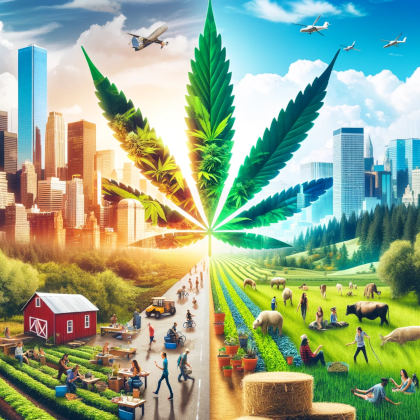
79% Of Americans Live In Legalized States
According to a recent analysis by the Pew Research Center, the vast majority of Americans live in states where cannabis has been legalized or decriminalized, and 79% of United States citizens live in a county with at least one dispensary. These numbers reflect a consistent trend in the overwhelming adoption of legalization by US states: now, marijuana is legal in two-thirds of the country, and states are continuing to reform their cannabis policies in response to the voices of their taxpayers.
Pew Research Analysis: Most Americans Live in or Near Legalized States, Yet Cannabis Remains Federally Illegal
According to the Pew Research Center report, the overwhelming majority of Americans live in or near legalized states, and most live in a county with at least one dispensary location. Here are some of the key statistics from the recent analysis:
- 74% of Americans live in a state where marijuana has been legalized for either medical or recreational use.
- 79% of Americans live in a county with at least one cannabis dispensary.
- 54% of Americans live in a state where recreational cannabis has been legalized. In these states, the process of purchasing marijuana is no more complicated than buying alcohol: anyone aged 21 and older can simply walk into a dispensary, show valid photo ID, and purchase legal cannabis products.
- There are nearly 15,000 cannabis dispensaries in the United States, with locations ranging from the West Coast to the Northeast, as well as throughout interior states such as Michigan, Oklahoma, and Colorado.
So why does marijuana continue to remain illegal at the federal level, where it’s classified as a Schedule I substance alongside heroin and cocaine as a drug with “no recognized medical potential”? And why are dispensaries still considered, per IRS 280E tax classification, as participants in the “trafficking” of “Schedule I drugs,” when these legitimate, state-licensed operations are merely doing precisely what they’ve been permitted to do under state law? Does the federal government want to see most of its citizens as criminals?
Paradoxical as it may seem, marijuana’s federally illegal status has placed an enormous burden upon cannabis businesses operating in legalized states, and the resounding impact of these outdated laws has negative implications for the entire cannabis community. Legitimate, lawful dispensaries–now legal in three-fourths of the country–continue to face unfair taxation, while lacking access to basic functions such as credit card services, reverting to cash-only operations that have caused dispensary burglaries to skyrocket. And all of this is taking place in states where marijuana has been legalized for medical or recreational use, while states where cannabis remains illegal are allowing black markets to capitalize upon the sale of unsafe, adulterated products.
The clear solution? For the federal government to take action by decriminalizing or legalizing cannabis. There’s a highly compelling case to be made for federal legalization, for reasons ranging from tax revenue, job creation, and public safety, to criminal reform, public health, and medical research. In this article, we dive into the statistics showing the ways in which individuals’ and states’ attitudes towards cannabis have continued to evolve, while the federal government remains moored in outdated laws and biases that no longer reflect the beliefs of the citizens it’s designated to serve.

Cannabis Markets Thrive Where Legalization is Well-Established
Moreover, it’s clear that Americans are utilizing their rights under these reformed state laws: dispensaries are soaring in popularity, even in states such as California, where medical cannabis has been legal since the 1990s.
California currently holds the nation’s record for the state with most dispensaries, with 3,669 dispensary storefronts, amounting to “more than double the amount [of dispensaries] in the next closed state.” Today, California is home to a quarter of America’s marijuana dispensaries, and 99.5% of Californians live in a county with at least one dispensary location. In fact, Los Angeles county alone is home to more dispensaries than any other state in America: “Los Angeles Country has more dispensaries (1,481) than any other state other than California itself,” the report states.
Oklahoma, meanwhile, has set the record for the state with most medical dispensaries per capita, boasting 36 cannabis storefronts per every 100,000 residents.
Today, 76% of the nation’s dispensaries are located in states that have legalized recreational marijuana, while the remaining 23% are in states that allow marijuana for medical purposes only. But within these states, dispensaries are by no means underrepresented. To the contrary, Oklahoma and Florida–where marijuana has been legalized only for medical purposes–are two of the top five states with the most dispensaries of any in the nation.
States with Restrictive Cannabis Laws Bordered by Hundreds of Dispensaries
For Americans who don’t reside in legalized states, access to legal cannabis isn’t far out of reach: even states with the most restrictive cannabis laws are located in close quarters with dispensary storefronts across their borders. According to Pew, 1 in every 5 US dispensaries are located within 20 miles of a state border, and 29% of these dispensaries are near borders adjoining neighboring states with more restrictive cannabis laws.
Take, for instance, Kansas, Texas, and Indiana, all of which are known for their restrictive marijuana policies. But this isn’t the only thing that these states have in common. All three are bordered by multiple, neighboring states that have legalized cannabis for either recreational or medical use, and that are home to hundreds or thousands of dispensaries where cannabis products are legally sold and purchased on a daily basis. In fact, anyone living in Kansas, Texas, or Indiana can find more than 100 dispensaries within just 20 miles of their respective state’s borders. Texas is a legal state, although limited.
“The patchwork of state laws governing the sale and use of marijuana means that many states have more permissive laws than their immediate neighbors do,” the report reads. “Our analysis finds concentrations of dispensaries near these borders between more and less permissive states.”
Analysis Corrects Presumptions About Dispensary Distribution & Low-Income Communities
Pew’s data has also corrected the argument, first voiced years ago by opponents during the early phases of legalization, that dispensaries would be overly represented in low-income neighborhoods. In reality, the balance is much more evenly distributed:
“The early years of marijuana legalization were marked by concerns that dispensaries would be clustered in low income neighborhoods…But this can vary quite a bit in individual states. In four states that have legalized marijuana for both recreational and medical purposes–Colorado, Connecticut, Maryland, and Virginia–median annual household incomes are at least $20,000 lower in areas with high concentrations of dispensaries than areas in the state with low concentrations of dispensaries. In New Hampshire and New York, by contrast, median household incomes are around $20,000 or more higher in areas with many dispensaries than in areas with few dispensaries.”
Clearly, then, Americans of all kinds are living in close proximity to dispensaries, and the vast majority of them have made their voices heard in support of legalization. And at the state level, governments are taking action, reforming cannabis policies in response to the voices of the taxpayers they serve, and allowing legal landscapes to evolve in order to reflect residents’ needs and desires.
Yet marijuana remains illegal at the federal level, making the federal government the minority when it comes to legalization, despite its duty to represent the states and citizens who have made their voices heard in support of cannabis reform.






